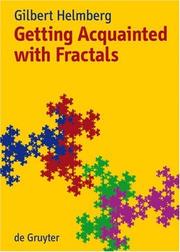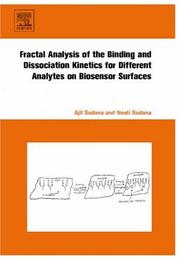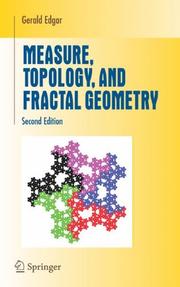| Listing 1 - 4 of 4 |
Sort by
|

ISBN: 1282196650 9786612196652 3110206617 9783110206616 9781282196650 3110190923 9783110190922 9783110190922 Year: 2008 Publisher: Berlin Boston
Abstract | Keywords | Export | Availability | Bookmark
 Loading...
Loading...Choose an application
- Reference Manager
- EndNote
- RefWorks (Direct export to RefWorks)
The first instance of pre-computer fractals was noted by the French mathematician Gaston Julia. He wondered what a complex polynomial function would look like, such as the ones named after him (in the form of z2 + c, where c is a complex constant with real and imaginary parts). The idea behind this formula is that one takes the x and y coordinates of a point z, and plug them into z in the form of x + i*y, where i is the square root of -1, square this number, and then add c, a constant. Then plug the resulting pair of real and imaginary numbers back into z, run the operation again, and keep doing that until the result is greater than some number. The number of times you have to run the equations to get out of an 'orbit' not specified here can be assigned a colour and then the pixel (x,y) gets turned that colour, unless those coordinates can't get out of their orbit, in which case they are made black. Later it was Benoit Mandelbrot who used computers to produce fractals. A basic property of fractals is that they contain a large degree of self similarity, i.e., they usually contain little copies within the original, and these copies also have infinite detail. That means the more you zoom in on a fractal, the more detail you get, and this keeps going on forever and ever. The well-written book 'Getting acquainted with fractals' by Gilbert Helmberg provides a mathematically oriented introduction to fractals, with a focus upon three types of fractals: fractals of curves, attractors for iterative function systems in the plane, and Julia sets. The presentation is on an undergraduate level, with an ample presentation of the corresponding mathematical background, e.g., linear algebra, calculus, algebra, geometry, topology, measure theory and complex analysis. The book contains over 170 color illustrations.
Fractals. --- Geometry. --- Mathematics --- Euclid's Elements --- Fractal geometry --- Fractal sets --- Geometry, Fractal --- Sets, Fractal --- Sets of fractional dimension --- Dimension theory (Topology) --- measure theory.

ISBN: 1281055646 9786611055646 0080555012 044453010X 9780444530103 9780080555010 9781281055644 Year: 2008 Publisher: Amsterdam ; London : Elsevier,
Abstract | Keywords | Export | Availability | Bookmark
 Loading...
Loading...Choose an application
- Reference Manager
- EndNote
- RefWorks (Direct export to RefWorks)
Biosensors are finding increasing applications in different areas. Over the last few years the areas where biosensors may be used effectively has increased dramatically. This book like the previous four books on analyte-receptor binding and dissociation kinetics by this author addresses the often neglected area. The kinetics of binding and dissociation in solution to appropriate receptors immobilized on biosensor surfaces occurs under diffusional limitations on structured surfaces. The receptors immobilized on the biosensor surface contribute to the degree of heterogeneity on the sensor ch
Surfaces (Technology) --- Fractals. --- Biosensors. --- Analysis. --- Biodetectors --- Biological detectors --- Biological sensors --- Biomedical detectors --- Biomedical sensors --- Detectors --- Medical instruments and apparatus --- Physiological apparatus --- Fractal geometry --- Fractal sets --- Geometry, Fractal --- Sets, Fractal --- Sets of fractional dimension --- Dimension theory (Topology) --- Characterization of surface --- Surface analysis --- Surface characterization --- Analytical chemistry --- Surface chemistry

ISBN: 0387747494 0387747486 1441925694 9780387747484 9781441925695 Year: 2008 Publisher: New York, NY : Springer New York : Imprint: Springer,
Abstract | Keywords | Export | Availability | Bookmark
 Loading...
Loading...Choose an application
- Reference Manager
- EndNote
- RefWorks (Direct export to RefWorks)
For the Second Edition of this highly regarded textbook, Gerald Edgar has made numerous additions and changes, in an attempt to provide a clearer and more focused exposition. The most important addition is an increased emphasis on the packing measure, so that now it is often treated on a par with the Hausdorff measure. The topological dimensions were rearranged for Chapter 3, so that the covering dimension is the major one, and the inductive dimensions are the variants. A "reduced cover class" notion was introduced to help in proofs for Method I or Method II measures. Research results since 1990 that affect these elementary topics have been taken into account. Some examples have been added, including Barnsley leaf and Julia set, and most of the figures have been re-drawn. From reviews of the First Edition: "...there has been a deluge of books, articles and television programmes about the beautiful mathematical objects, drawn by computers using recursive or iterative algorithms, which Mandelbrot christened fractals. Gerald Edgar's book is a significant addition to this deluge. Based on a course given to talented high school students at Ohio University in 1988, it is, in fact, an advanced undergraduate textbook about the mathematics of fractal geometry, treating such topics as metric spaces, measure theory, dimension theory, and even some algebraic topology...the book also contains many good illustrations of fractals..." - Mathematics Teaching "The book can be recommended to students who seriously want to know about the mathematical foundation of fractals, and to lecturers who want to illustrate a standard course in metric topology by interesting examples." - Christoph Bandt, Mathematical Reviews "...not only intended to fit mathematics students who wish to learn fractal geometry from its beginning but also students in computer science who are interested in the subject. [For such students] the author gives the required topics from metric topology and measure theory on an elementary level. The book is written in a very clear style and contains a lot of exercises which should be worked out." - H.Haase, Zentralblatt.
Mathematics. --- Measure theory. --- Functions of real variables. --- Geometry. --- Topology. --- Real Functions. --- Measure and Integration. --- Analysis situs --- Position analysis --- Rubber-sheet geometry --- Geometry --- Polyhedra --- Set theory --- Algebras, Linear --- Lebesgue measure --- Measurable sets --- Measure of a set --- Algebraic topology --- Integrals, Generalized --- Measure algebras --- Rings (Algebra) --- Mathematics --- Euclid's Elements --- Real variables --- Functions of complex variables --- Math --- Science --- Fractals. --- Fractal geometry --- Fractal sets --- Geometry, Fractal --- Sets, Fractal --- Sets of fractional dimension --- Dimension theory (Topology) --- Fractals --- Measure theory --- Topology
Book
ISBN: 1281872431 9786611872434 376438882X 3764388811 Year: 2008 Publisher: Basel : [London : Birkhäuser ; Springer, distributor],
Abstract | Keywords | Export | Availability | Bookmark
 Loading...
Loading...Choose an application
- Reference Manager
- EndNote
- RefWorks (Direct export to RefWorks)
The main objective of this book is to give a broad unified introduction to the study of dimension and recurrence in hyperbolic dynamics. It includes the discussion of the foundations, main results, and main techniques in the rich interplay of four main areas of research: hyperbolic dynamics, dimension theory, multifractal analysis, and quantitative recurrence. It also gives a panorama of several selected topics of current research interest. More than half of the material appears here for the first time in book form, describing many recent developments in the area such as topics on irregular sets, variational principles, applications to number theory, measures of maximal dimension, multifractal nonrigidity, and quantitative recurrence. All the results are included with detailed proofs, many of them simplified or rewritten on purpose for the book. The text is self-contained and directed to researchers as well as graduate students that wish to have a global view of the theory together with a working knowledge of its main techniques. It will also be useful as as basis for graduate courses in dimension theory of dynamical systems, multifractal analysis, and pointwise dimension and recurrence in hyperbolic dynamics.
Differentiable dynamical systems. --- Hyperbolic groups. --- Dimension theory (Topology) --- Topology --- Group theory --- Differential dynamical systems --- Dynamical systems, Differentiable --- Dynamics, Differentiable --- Differential equations --- Global analysis (Mathematics) --- Topological dynamics --- Cell aggregation --- Global analysis (Mathematics). --- Dynamical Systems and Ergodic Theory. --- Manifolds and Cell Complexes (incl. Diff.Topology). --- Analysis. --- Mathematics. --- Analysis, Global (Mathematics) --- Differential topology --- Functions of complex variables --- Geometry, Algebraic --- Aggregation, Cell --- Cell patterning --- Cell interaction --- Microbial aggregation --- Dynamics. --- Ergodic theory. --- Manifolds (Mathematics). --- Complex manifolds. --- Mathematical analysis. --- Analysis (Mathematics). --- 517.1 Mathematical analysis --- Mathematical analysis --- Analytic spaces --- Manifolds (Mathematics) --- Geometry, Differential --- Ergodic transformations --- Continuous groups --- Mathematical physics --- Measure theory --- Transformations (Mathematics) --- Dynamical systems --- Kinetics --- Mathematics --- Mechanics, Analytic --- Force and energy --- Mechanics --- Physics --- Statics
| Listing 1 - 4 of 4 |
Sort by
|

 Search
Search Feedback
Feedback About UniCat
About UniCat  Help
Help News
News